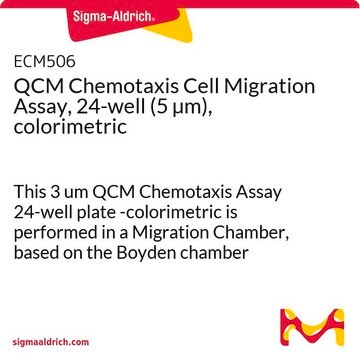ECM512
QCM Chemotaxis Cell Migration Assay, 96-well (5 µm), fluorimetric
The QCM 5 um 96-well Migration Assay utilizes a 5 um pore size, which is appropriate for studying monocyte/macrophage migration.
Synonym(s):
5 μm pore migration invasion assay, monocyte macrophage migration assay
Sign Into View Organizational & Contract Pricing
All Photos(2)
About This Item
UNSPSC Code:
12352207
eCl@ss:
32161000
NACRES:
NA.32
Recommended Products
Quality Level
species reactivity (predicted by homology)
all
manufacturer/tradename
Chemicon®
QCM
technique(s)
activity assay: suitable
cell based assay: suitable
detection method
fluorometric
shipped in
wet ice
Related Categories
Application
Research Category
Cell Structure
Cell Structure
Packaging
96 wells
Legal Information
CHEMICON is a registered trademark of Merck KGaA, Darmstadt, Germany
Disclaimer
Unless otherwise stated in our catalog or other company documentation accompanying the product(s), our products are intended for research use only and are not to be used for any other purpose, which includes but is not limited to, unauthorized commercial uses, in vitro diagnostic uses, ex vivo or in vivo therapeutic uses or any type of consumption or application to humans or animals.
signalword
Danger
hcodes
Hazard Classifications
Aquatic Acute 1 - Aquatic Chronic 2 - Eye Dam. 1
Storage Class
10 - Combustible liquids
Certificates of Analysis (COA)
Search for Certificates of Analysis (COA) by entering the products Lot/Batch Number. Lot and Batch Numbers can be found on a product’s label following the words ‘Lot’ or ‘Batch’.
Already Own This Product?
Find documentation for the products that you have recently purchased in the Document Library.
Customers Also Viewed
Karen S Aboody et al.
Science translational medicine, 5(184), 184ra59-184ra59 (2013-05-10)
High-grade gliomas are extremely difficult to treat because they are invasive and therefore not curable by surgical resection; the toxicity of current chemo- and radiation therapies limits the doses that can be used. Neural stem cells (NSCs) have inherent tumor-tropic
Shrinidh Joshi et al.
Journal of cellular physiology, 234(11), 20420-20431 (2019-04-17)
CD34+ hematopoietic stem/progenitor cells (HSPCs) are vasculogenic and hypoxia is a strong stimulus for the vasoreparative functions of these cells. Angiotensin-converting enzyme 2 (ACE2)/angiotensin-(1-7)/Mas receptor (MasR) pathway stimulates vasoprotective functions of CD34+ cells. This study tested if ACE2 and MasR
Iryna A Falkenstein et al.
Current eye research, 33(7), 599-609 (2008-07-05)
To investigate the intraocular properties and toxicity of IMS2186, a small molecule developed as an anti-choroidal neovascularization (anti-CNV) drug. Cellular toxicity and mechanism of action was tested on cell lines in vitro. Intraocular studies used rabbits for drug dissolution as
Scott Ferguson et al.
The AAPS journal, 20(4), 67-67 (2018-05-02)
Exosomes are nano-sized vesicles composed of lipids, proteins, and nucleic acids. Their molecular landscape is diverse, and exosomes derived from different cell types have distinct biological activities. Since exosomes are now being utilized as delivery vehicles for exogenous therapeutic cargoes
Jing Wu et al.
Stem cells international, 2022, 4249843-4249843 (2022-08-16)
Impairment of bone marrow-derived hematopoietic stem/progenitor cells (HSPCs) contributes to the progression of vascular complications in subjects with diabetes. Very small amounts of bacterial-derived pathogen-associated molecular patterns (PAMPs) establish the bone marrow cell pool. We hypothesize that alteration of the
Our team of scientists has experience in all areas of research including Life Science, Material Science, Chemical Synthesis, Chromatography, Analytical and many others.
Contact Technical Service













